Featured Past Articles
 His Excellency Daniel Toroitich Arap Moi, Farmer number one for those who grew up in 80s and 90s, a flower farmer and chairman to one of the fastest growing group in the sector, former president and crusader for agriculture as a whole, was promoted to glory on Tuesday, February 4, peacefully. He was 95. All the flowers used during the occasion came from his farms. It was a fitting salute to his dedication, not only to his farms, but to the industry he loved.
His Excellency Daniel Toroitich Arap Moi, Farmer number one for those who grew up in 80s and 90s, a flower farmer and chairman to one of the fastest growing group in the sector, former president and crusader for agriculture as a whole, was promoted to glory on Tuesday, February 4, peacefully. He was 95. All the flowers used during the occasion came from his farms. It was a fitting salute to his dedication, not only to his farms, but to the industry he loved.
True be said, the industry lost an international investor the flower industry, an enthusiastic educator, a devoted volunteer and a friend to many.
The Flower industry is but one of many sectors who will feel an enormous void with Mzee Moi’s passing. “Mzee Moi was a prolific contributor of practical, easily relatable and accurate GAPs, both as government policy and as a farmer. In more than 20 years of working close to Mzee Moi’s farms, they are professionally run and most of the other farms have benefited immensely from their professionality. I have also learnt a lot every time I visit them.
 Due to the impact of the 2019- CoV, the 2020 China International Floriculture & Horticulture Trade Fair (Flower Expo China) will be rescheduled for a new date and venue.
Due to the impact of the 2019- CoV, the 2020 China International Floriculture & Horticulture Trade Fair (Flower Expo China) will be rescheduled for a new date and venue.
The event was originally slated for March 16th-18th, 2020 at Guangzhou International Sourcing Center, and is now moved to May 11th-13th, 2020 at Hall 3 - Hall 4 at Guangzhou Poly World Trade Center Expo.
Coronavirus impacts international flower trade
“Gesundheit startet hier!” That’s what the disinfection gel dispensers read at the IPM Essen last week. The Chinese hall was empty during the Fruit Logistica show in Berlin. The effects of the coronavirus outbreak in the industry though are more broad.
Since the Chinese holidays are extended and many flights are canceled, projects will be delayed. Due to the coronavirus the trade at the markets is shut down as well: with no logistics and no trade on the markets, the market is silent. We spoke to several people in the industry to learn more about the situation and the impact on the international horti- and floriculture industry - particularly now, in the run-up to Valentine’s Day.
Read more: Flower Expo China postponed due to COVID-19 virus
"Dr Lisbeth Riis, founder and CEO at Scarab Solutions, has explained how the cut flower industry can significantly benefit by replicating the principles of digital mapping of pests and diseases to the plants in their greenhouses Using satellites, GPS tracking and mapping software to create Geographic Information Systems, very detailed maps were produced from the data collected.”
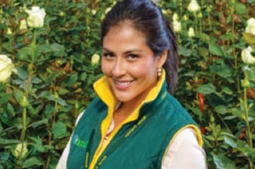 Pest and disease mapping in any environment has far-reaching effects. Thirty years ago, wild poliovirus was present in more than 125 countries and paralysed 350,000 people every year, primarily young children. Now incredibly targeted tracking and mapping efforts, combined with a global immunisation program by Global Polio Eradication Initiative (GPEI), have reduced the number of cases by more than 99 per cent, saving more than 13 million children from paralysis.
Pest and disease mapping in any environment has far-reaching effects. Thirty years ago, wild poliovirus was present in more than 125 countries and paralysed 350,000 people every year, primarily young children. Now incredibly targeted tracking and mapping efforts, combined with a global immunisation program by Global Polio Eradication Initiative (GPEI), have reduced the number of cases by more than 99 per cent, saving more than 13 million children from paralysis.
Lessons learned from human diseases can be applied to horticulture
It seems that while these advanced techniques are now prevalent for human diseases, not enough has changed in the cut flower greenhouses in Africa and Latin America, where a large amount of the world’s cut flowers are grown. Mapping of pests and diseases in horticulture is still often a manual, inaccurate and inefficient process relying on paper-based analysis and individual knowledge.
Typical farmers expect to lose five to 10 per cent of yield to pest and diseases, which is why effective control can greatly increase the number of plants sent for harvest in the first place. Not only do they benefit in terms of the total yield—but they can also better focus staff and resources on the farm and even limit wastage of pesticides and biological control agents.
Read more: How Pest and Disease Mapping Makes a Difference To Yield and Cost Control
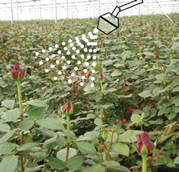 Downy mildew in roses is caused by an obligate biotrophic oomycete in the family peronosporacea namely Peronospora sparsa. As the scientific name indicates, the production of spores is sparse and therefore this disease is difficult to diagnose and control. It attacks all types of roses both in the greenhouse, nursery and the landscape from potted miniatures to landscape-size roses and even shrub roses. It causes destruction of leaves, stems, and flowers of the infected plant. The pathogen produces zoospores that have flagella they use to “swim” to ideal infection sites. That is why wet plant surfaces make the disease much more prevalent.
Downy mildew in roses is caused by an obligate biotrophic oomycete in the family peronosporacea namely Peronospora sparsa. As the scientific name indicates, the production of spores is sparse and therefore this disease is difficult to diagnose and control. It attacks all types of roses both in the greenhouse, nursery and the landscape from potted miniatures to landscape-size roses and even shrub roses. It causes destruction of leaves, stems, and flowers of the infected plant. The pathogen produces zoospores that have flagella they use to “swim” to ideal infection sites. That is why wet plant surfaces make the disease much more prevalent.
The fungus overwinters in or on plant parts as a vegetative mycelium or in fallen plant debris as hardy Oospores. The pathogen has short development cycles under optimum conditions, produces high quantities of spores and causes an irreversible damage to the crop.
Read more: Downy Mildew Management in Roses…The Best Way to Go
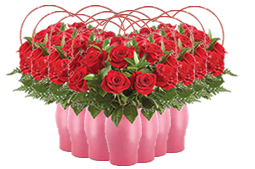 Florist Zhong Wenping is usually racing around at valentine’s time, preparing for Valentine’s Day. But this year her flower shop in Jingshan, a small city in central Hubei province, was quiet.
Florist Zhong Wenping is usually racing around at valentine’s time, preparing for Valentine’s Day. But this year her flower shop in Jingshan, a small city in central Hubei province, was quiet.
Like many places in the province at the centre of a deadly coronavirus outbreak, the streets of Jingshan were empty. Wedding banquets and other events were on hold. The shops are shut, as are cinemas, karaoke bars, restaurants and even banks. Checkpoints and guard posts have been set up at the entrance to every public building, and residential communities are in lockdown as authorities try to contain the outbreak that is believed to have started at a live animal and seafood market in the provincial capital Wuhan in December.
“It should have been the busiest day of the year for me because the Lunar New Year holiday is over and everyone should have been back to work,” Zhong told the South China Morning Post.
“I should have started preparing roses a week ago, but people haven’t been able to leave their homes since late last month – let alone do any celebrating,” she said. “Also, how can you really sterilise flowers?”
Read more: COVID-19 Dampens Valentine’s Day Spirits in China
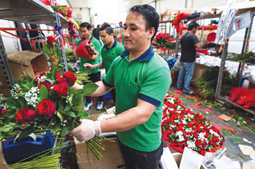 If you are feeling anxious about Valentine’s Day, spare a thought for those working in the floral industry. For them, this is the busiest time of the year, and it’s largely about just one flower: the ubiquitous red rose.
If you are feeling anxious about Valentine’s Day, spare a thought for those working in the floral industry. For them, this is the busiest time of the year, and it’s largely about just one flower: the ubiquitous red rose.
Ahead of February 14, Gulf News visited Black Tulip Flowers, the region’s largest floral company, to gain an insight into how they deliver millions of Valentine’s Day roses in 35 countries worldwide.
The Sharjah-based company begins operations at 3.45am when most of us are still in bed, to prepare for their biggest days of flower sales.
“We are the third largest flower grower in the world and this is the peak time for our business so one can well imagine what’s it like here,” said the company’s owner and chairman M.M. Ehiya, an Indian expert who started from a small flower shop on Sharjah’s King Faisal Road in 1990.
Read more: Valentine’s Day in UAE: Where Will Your Rose be Coming From?
Finlays shut down their farms, Chemirei and Tarakwet, in Kericho (Kenya) on 25th December. However, they will continue to expand their Lemotit farm in Londiani, and they will double the size of their packhouse. But what is the reason for the closedown of the Kericho Farm? What will happen with the employees and how will they continue? We had a chat with Piet Kelderman, Commercial Manager of Finlay Flowers who explained it all.
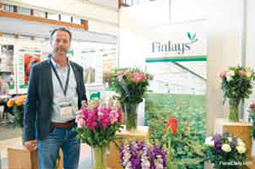 The shutdown - costs too high
The shutdown - costs too high
In April 2018 Finlay Flowers announced that it would be closing its operations in Kericho over a three year phased program. Recently, the company decided to accelerate the closure and brought the date forward by twelve months. But what was the reason for this decision? “The costs”, says Kelderman, “Specifically around labour. When Finlay Flowers started in Kericho in 1989, its labour costs were aligned with the tea industry and it remains like this to this day. The salaries are higher – approximately twice as high as the rest of the flower industry in Kenya and this has made the farms in Kericho uncompetitive.”
Read more: Finlays shuts down Kericho farms, but expands Londiani farm Pieter Kelderman explains


